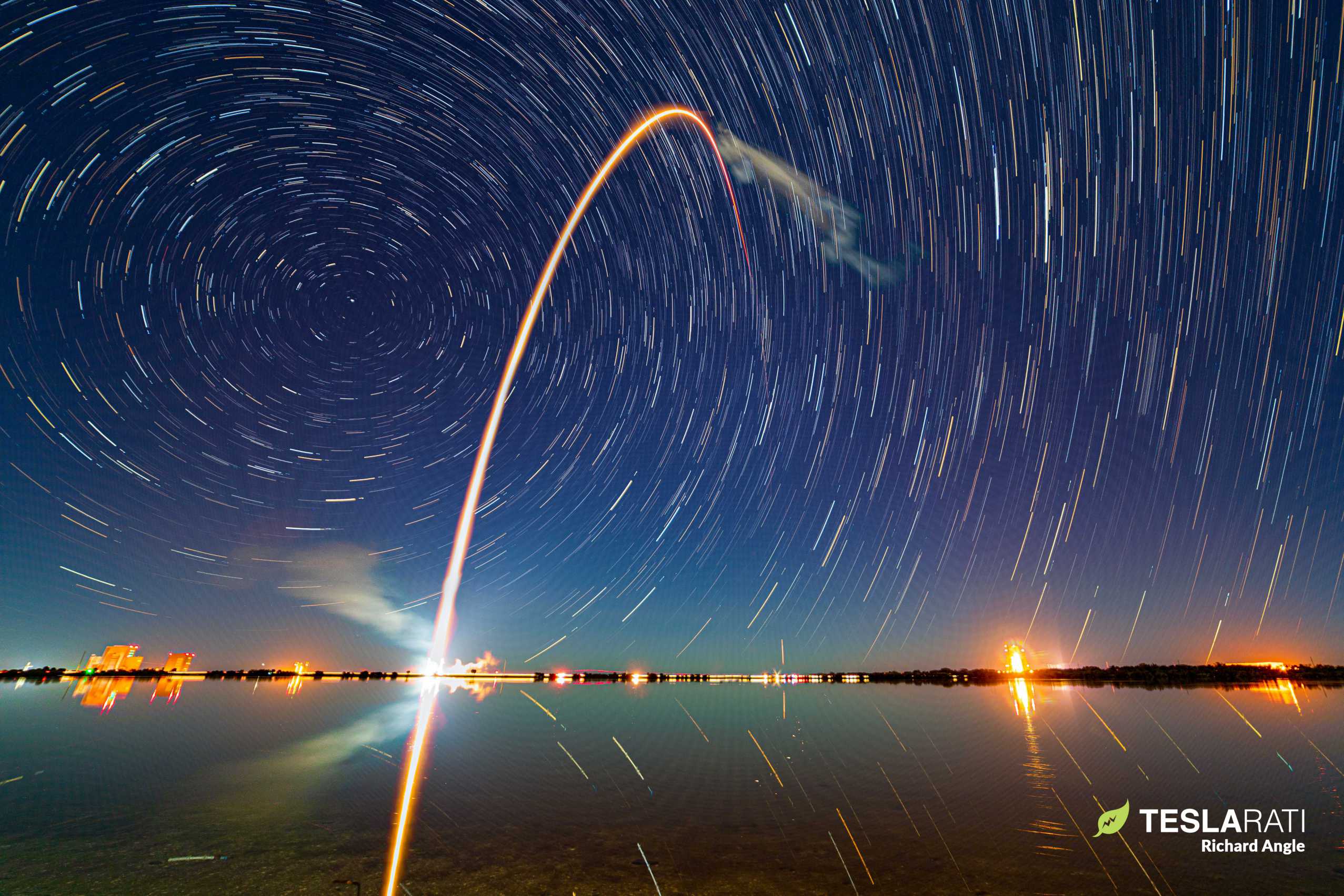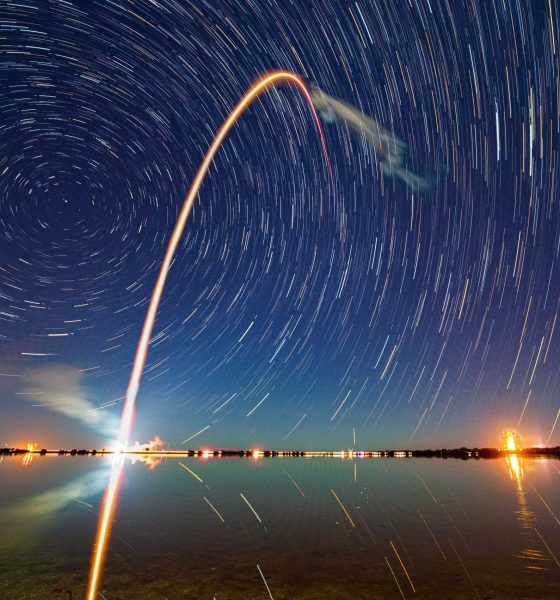

News
SpaceX Starlink antennas spied at Starship factory for the first time ever
SpaceX’s mysterious Starlink ‘user terminals’ have been spotted in public for the first time ever at the company’s South Texas Starship factory.
Offering a first-ever glimpse of the hardware that individual customers will use to connect to SpaceX’s growing satellite internet network, the lone photo provides a bit more detail than it might initially seem. Effectively invisible up to now, the user terminal – a small antenna system – has been described by both SpaceX CEO Elon Musk and COO/President Gwynne Shotwell as a the single biggest challenge standing in the way of Starlink’s success.
For SpaceX, building a mass-market consumer electronics product more or less in-house was already guaranteed to be a major (and expensive) challenge. The complex requirements and limitations facing an antenna meant for a low Earth orbit (LEO) satellite internet constellation thus magnify a task that is already hard and turn it into a truly unprecedented feat of mass production. Regardless, SpaceX continues to persevere and the first public appearance of user terminals – as well as the consistent company position that service could begin rolling out just a few months from now – are encouraging signs.

The single biggest reason the user terminal component of Starlink is so daunting is relatively simple. Situated in low Earth orbit (LEO) to ensure that Starlink internet service offers latency (ping, response time, etc.) as good or better than fiber, the SpaceX satellites are moving quite rapidly, spending just a handful of minutes over any given spot on the Earth’s surface. Whereas existing satellite internet solutions are located in much higher orbits, including geostationary orbits where the spacecraft actually appear to hover above a fixed point on the ground, ground antennas for LEO internet constellations are much more challenging.
Instead of a literal dish tracking satellites as they streak across the sky, the only truly viable solution is an electronically-steered (phased array) antenna. The problem is that while phased array antennas have plummeted in price over the last five or so years, the going price for existing solutions puts them somewhere between one and two magnitudes too expensive mass-market consumer product. Even if customers loathe Comcast with all their hearts, the vast majority simply can’t rationalize spending thousands of dollars up front for comparable satellite service.

In other words, for Starlink to be viable regardless of the quality or affordability of the satellites themselves, SpaceX must somehow find a way to build millions of user terminals that are simultaneously far more capable than anything in their price range and as good or better than antennas that cost $5,000, $10,000, or even more. The challenge is amplified further by the fact that competing ground-based internet service providers (ISP) like Comcast incur nearly no material cost to add a customer to their network, while customers will typically already have the router and modem needed to gain access.
On top of being at least 5-10 times cheaper than comparable alternatives, Starlink user terminals must also be impressively reliable, bug-free, and easy to set up. Beyond that, though, the amount of room for improvement available to SpaceX is almost comical. Even mediocre customer service and vaguely transparent bills and pricing would likely paint Starlink in a favorable and highly preferable light when compared with the United States’ infamous ecosystem of monopolistic ISPs. Many consumers may happily spend several times more money than they’ve ever spent on internet-related technology just to gain access to Starlink and escape the yoke of their existing ISP.
According to Shotwell, SpaceX could begin rolling out Starlink internet to customers in the northern US and southern Canada once 14 batches – ~840 operational spacecraft – have been launched. SpaceX’s next Starlink v1.0 launch is scheduled as soon as June 23rd, meaning that an initial rollout could come as early as August or September.
Check out Teslarati’s Marketplace! We offer Tesla accessories, including for the Tesla Cybertruck and Tesla Model 3.

News
Tesla (TSLA) receives “Buy” rating and $551 PT from Canaccord Genuity
He also maintained a “Buy” rating for TSLA stock over the company’s improving long-term outlook, which is driven by autonomy and robotics.

Canaccord Genuity analyst George Gianarikas raised his Tesla (NASDAQ:TSLA) price target from $482 to $551. He also maintained a “Buy” rating for TSLA stock over the company’s improving long-term outlook, which is driven by autonomy and robotics.
The analyst’s updated note
Gianarikas lowered his 4Q25 delivery estimates but pointed to several positive factors in the Tesla story. He noted that EV adoption in emerging markets is gaining pace, and progress in FSD and the Robotaxi rollout in 2026 represent major upside drivers. Further progress in the Optimus program next year could also add more momentum for the electric vehicle maker.
“Overall, yes, 4Q25 delivery expectations are being revised lower. However, the reset in the US EV market is laying the groundwork for a more durable and attractive long-term demand environment.
“At the same time, EV penetration in emerging markets is accelerating, reinforcing Tesla’s potential multi‑year growth runway beyond the US. Global progress in FSD and the anticipated rollout of a larger robotaxi fleet in 2026 are increasingly important components of the Tesla equity story and could provide sentiment tailwinds,” the analyst wrote.
Tesla’s busy 2026
The upcoming year would be a busy one for Tesla, considering the company’s plans and targets. The autonomous two-seat Cybercab has been confirmed to start production sometime in Q2 2026, as per Elon Musk during the 2025 Annual Shareholder Meeting.
Apart from this, Tesla is also expected to unveil the next-generation Roadster on April 1, 2026. Tesla is also expected to start high-volume production of the Tesla Semi in Nevada next year.
Apart from vehicle launches, Tesla has expressed its intentions to significantly ramp the rollout of FSD to several regions worldwide, such as Europe. Plans are also underway to launch more Robotaxi networks in several more key areas across the United States.
News
Waymo sues Santa Monica over order to halt overnight charging sessions
In its complaint, Waymo argued that its self-driving cars’ operations do not constitute a public nuisance, and compliance with the city’s order would cause the company irreparable harm.

Waymo has filed a lawsuit against the City of Santa Monica in Los Angeles County Superior Court, seeking to block an order that requires the company to cease overnight charging at two facilities.
In its complaint, Waymo argued that its self-driving cars’ operations do not constitute a public nuisance, and compliance with the city’s order would cause the company irreparable harm.
Nuisance claims
As noted in a report from the Los Angeles Times, Waymo’s two charging sites at Euclid Street and Broadway have operated for about a year, supporting the company’s growing fleet with round-the-clock activity. Unfortunately, this has also resulted in residents in the area reportedly being unable to sleep due to incessant beeping from self-driving taxis that are moving in and out of the charging stations around the clock.
Frustrated residents have protested against the Waymos by blocking the vehicles’ paths, placing cones, and “stacking” cars to create backups. This has also resulted in multiple calls to the police.
Last month, the city issued an order to Waymo and its charging partner, Voltera, to cease overnight operations at the charging locations, stating that the self-driving vehicles’ activities at night were a public nuisance. A December 15 meeting yielded no agreement on mitigations like software rerouting. Waymo proposed changes, but the city reportedly insisted that nothing would satisfy the irate residents.
“We are disappointed that the City has chosen an adversarial path over a collaborative one. The City’s position has been to insist that no actions taken or proposed by Waymo would satisfy the complaining neighbors and therefore must be deemed insufficient,” a Waymo spokesperson stated.
Waymo pushes back
In its legal complaint, Waymo stated that its “activities at the Broadway Facilities do not constitute a public nuisance.” The company also noted that it “faces imminent and irreparable harm to its operations, employees, and customers” from the city’s order. The suit also stated that the city was fully aware that the Voltera charging sites would be operating around the clock to support Waymo’s self-driving taxis.
The company highlighted over one million trips in Santa Monica since launch, with more than 50,000 rides starting or ending there in November alone. Waymo also criticized the city for adopting a contentious strategy against businesses.
“The City of Santa Monica’s recent actions are inconsistent with its stated goal of attracting investment. At a time when the City faces a serious fiscal crisis, officials are choosing to obstruct properly permitted investment rather than fostering a ‘ready for business’ environment,” Waymo stated.
News
Tesla FSD v14.2.2 is getting rave reviews from drivers
So far, early testers have reported buttery-smooth drives with confident performance, even at night or on twisty roads.

Tesla Full Self-Driving (Supervised) v14.2.2 is receiving positive reviews from owners, with several drivers praising the build’s lack of hesitation during lane changes and its smoother decision-making, among others.
The update, which started rolling out on Monday, also adds features like dynamic arrival pin adjustment. So far, early testers have reported buttery-smooth drives with confident performance, even at night or on twisty roads.
Owners highlight major improvements
Longtime Tesla owner and FSD user @BLKMDL3 shared a detailed 10-hour impression of FSD v14.2.2, noting that the system exhibited “zero lane change hesitation” and “extremely refined” lane choices. He praised Mad Max mode’s performance, stellar parking in locations including ticket dispensers, and impressive canyon runs even in dark conditions.
Fellow FSD user Dan Burkland reported an hour of FSD v14.2.2’s nighttime driving with “zero hesitations” and “buttery smooth” confidence reminiscent of Robotaxi rides in areas such as Austin, Texas. Veteran FSD user Whole Mars Catalog also demonstrated voice navigation via Grok, while Tesla owner Devin Olsen completed a nearly two-hour drive with FSD v14.2.2 in heavy traffic and rain with strong performance.
Closer to unsupervised
FSD has been receiving rave reviews, even from Tesla’s competitors. Xpeng CEO He Xiaopeng, for one, offered fresh praise for FSD v14.2 after visiting Silicon Valley. Following extended test drives of Tesla vehicles running the latest FSD software, He stated that the system has made major strides, reinforcing his view that Tesla’s approach to autonomy is indeed the proper path towards autonomy.
According to He, Tesla’s FSD has evolved from a smooth Level 2 advanced driver assistance system into what he described as a “near-Level 4” experience in terms of capabilities. While acknowledging that areas of improvement are still present, the Xpeng CEO stated that FSD’s current iteration significantly surpasses last year’s capabilities. He also reiterated his belief that Tesla’s strategy of using the same autonomous software and hardware architecture across private vehicles and robotaxis is the right long-term approach, as it would allow users to bypass intermediate autonomy stages and move closer to Level 4 functionality.








